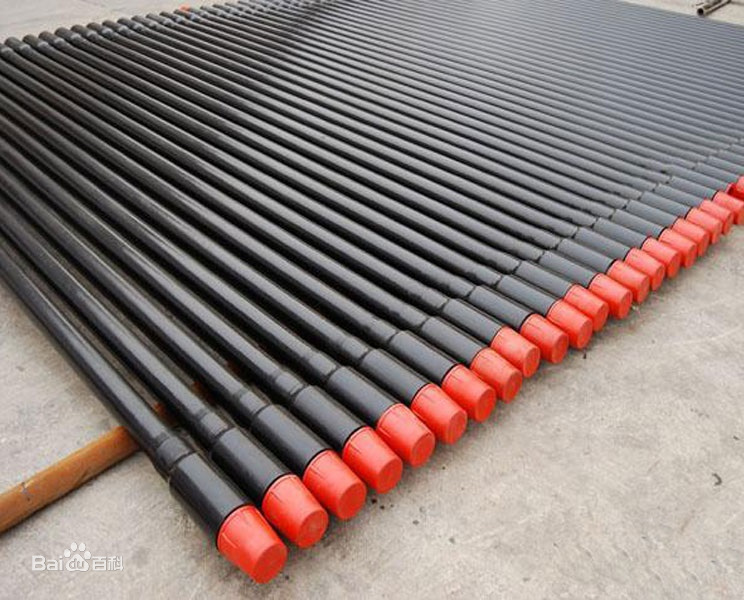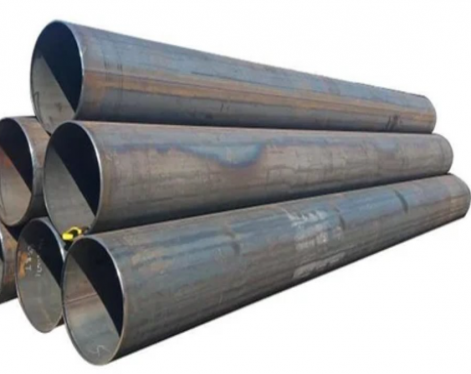Drill pipe
The drill pipe is a steel pipe with threads at the end, which is used to connect the surface equipment of the drilling rig and the drilling and grinding equipment or the bottom hole device at the bottom of the drilling well.
Drill pipes are divided into three categories: kelly, drill pipe and heavy drill pipe. The connection sequence is kelly (1 piece) + drill pipe (n pieces, determined by the well depth) + heavy drill pipe (n pieces, determined by the design of the drilling tool assembly)
(1) The kelly is located at the top of the drill string, and there are two types: square and hexagonal
effect
①During drilling, the kelly is matched with the bushing and the turntable bushing, and the ground rotation torque is transmitted to the drill pipe to drive the drill string and the drill bit to rotate;
② Bear the full weight of the drill string;
③ Channels for drilling fluid circulation.
(2) drill pipe
Function: The drill pipe is the basic component of the drill string. Its main function is to transmit torque and transport drilling fluid, and the wellbore is continuously deepened by the gradual lengthening of the drill pipe. Therefore, drill pipe plays a very important role in oil drilling.
structure:
①The drill pipe is made of seamless pipe, and the wall thickness is generally 9-11mm;
②The drill pipe body and the drill pipe joint are composed of two parts: the pipe body and the joint are butt welded together by friction welding.
(3) Heavy drill pipe
The weighted drill pipe is similar to the oil drill pipe, and it is also a hollow steel column with a length of about 10 meters. But the single weight is heavier than the oil drill pipe, and the wall thickness is 2 to 3 times that of the drill pipe. The weighted drill pipe is connected between the drill pipe and the drill collar to prevent fatigue damage due to the change of the section of the drill string. It can also replace part of the drill collar
The basic functions of the drill string are:
(1) Lifting and lowering the drill bit;
(2) apply drilling pressure;
(3) transmission of power;
(4) Transport drilling fluid;
(5) Carry out special operations: squeeze cement, deal with underground accidents, etc.

Drill Collar
The drill collar is at the bottom of the drill string and is the main component of the lower drill tool assembly. Its main feature is that the wall thickness is large (generally 38~53mm, equivalent to 4~6 times the wall thickness of the drill pipe), and it has greater gravity and rigidity. In order to facilitate the tripping work, elevator grooves and slip grooves can be processed on the outer surface of the inner thread of the drill collar.
Drill collars are generally divided into three types: spiral drill collars, non-magnetic drill collars, and integral drill collars.
(1) The integral drill collar is a smooth thick-walled round tube with connecting threads processed at both ends.
(2) The helical drill collar is processed with 3 right-handed helical grooves on the outer cylindrical surface of the round drill collar to reduce the contact area with the well wall, which can effectively prevent the pressure difference from sticking the drill
(3) Non-magnetic drill collars are mainly used for monitoring during oil drilling, and the structure is the same as that of integral drill collars.
In order to facilitate the tripping work, elevator grooves and slip grooves can be processed on the outer surface of the inner thread of the drill collar.
Due to the continuous updating and improvement of drilling equipment for exploration and development, the drilling speed is accelerated and the drilling depth is increased. It is necessary to connect a certain length of thick-walled non-magnetic drill collar made of weakly magnetic and difficult-to-magnetize stainless steel at the lower part of the drill string (the wall thickness is generally between 30mm-103mm)
The role of drill collars
(1) Apply drilling pressure to the drill bit;
(2) Ensure the necessary strength under compression conditions;
(3) Reduce the vibration, swing, and jump of the drill bit, so that the drill bit works smoothly;
(4) Control well deviation.
Tips: Both drill pipe and drill collar are part of octg pipe
The drill pipe is a steel pipe with threads at the end, which is used to connect the surface equipment of the drilling rig and the drilling and grinding equipment or the bottom hole device at the bottom of the drilling well.
Drill pipes are divided into three categories: kelly, drill pipe and heavy drill pipe. The connection sequence is kelly (1 piece) + drill pipe (n pieces, determined by the well depth) + heavy drill pipe (n pieces, determined by the design of the drilling tool assembly)
(1) The kelly is located at the top of the drill string, and there are two types: square and hexagonal
effect
①During drilling, the kelly is matched with the bushing and the turntable bushing, and the ground rotation torque is transmitted to the drill pipe to drive the drill string and the drill bit to rotate;
② Bear the full weight of the drill string;
③ Channels for drilling fluid circulation.
(2) drill pipe
Function: The drill pipe is the basic component of the drill string. Its main function is to transmit torque and transport drilling fluid, and the wellbore is continuously deepened by the gradual lengthening of the drill pipe. Therefore, drill pipe plays a very important role in oil drilling.
structure:
①The drill pipe is made of seamless pipe, and the wall thickness is generally 9-11mm;
②The drill pipe body and the drill pipe joint are composed of two parts: the pipe body and the joint are butt welded together by friction welding.
(3) Heavy drill pipe
The weighted drill pipe is similar to the oil drill pipe, and it is also a hollow steel column with a length of about 10 meters. But the single weight is heavier than the oil drill pipe, and the wall thickness is 2 to 3 times that of the drill pipe. The weighted drill pipe is connected between the drill pipe and the drill collar to prevent fatigue damage due to the change of the section of the drill string. It can also replace part of the drill collar
The basic functions of the drill string are:
(1) Lifting and lowering the drill bit;
(2) apply drilling pressure;
(3) transmission of power;
(4) Transport drilling fluid;
(5) Carry out special operations: squeeze cement, deal with underground accidents, etc.

Drill Collar
The drill collar is at the bottom of the drill string and is the main component of the lower drill tool assembly. Its main feature is that the wall thickness is large (generally 38~53mm, equivalent to 4~6 times the wall thickness of the drill pipe), and it has greater gravity and rigidity. In order to facilitate the tripping work, elevator grooves and slip grooves can be processed on the outer surface of the inner thread of the drill collar.
Drill collars are generally divided into three types: spiral drill collars, non-magnetic drill collars, and integral drill collars.
(1) The integral drill collar is a smooth thick-walled round tube with connecting threads processed at both ends.
(2) The helical drill collar is processed with 3 right-handed helical grooves on the outer cylindrical surface of the round drill collar to reduce the contact area with the well wall, which can effectively prevent the pressure difference from sticking the drill
(3) Non-magnetic drill collars are mainly used for monitoring during oil drilling, and the structure is the same as that of integral drill collars.
In order to facilitate the tripping work, elevator grooves and slip grooves can be processed on the outer surface of the inner thread of the drill collar.
Due to the continuous updating and improvement of drilling equipment for exploration and development, the drilling speed is accelerated and the drilling depth is increased. It is necessary to connect a certain length of thick-walled non-magnetic drill collar made of weakly magnetic and difficult-to-magnetize stainless steel at the lower part of the drill string (the wall thickness is generally between 30mm-103mm)
The role of drill collars
(1) Apply drilling pressure to the drill bit;
(2) Ensure the necessary strength under compression conditions;
(3) Reduce the vibration, swing, and jump of the drill bit, so that the drill bit works smoothly;
(4) Control well deviation.
Tips: Both drill pipe and drill collar are part of octg pipe









